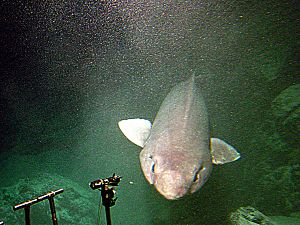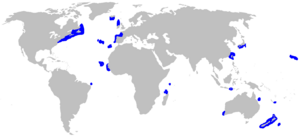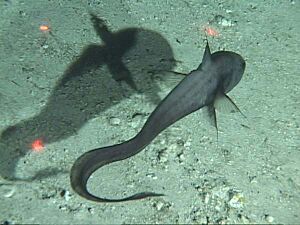False catshark facts for kids
Quick facts for kids False catshark |
|
|---|---|
 |
|
| Conservation status | |
| Scientific classification | |
| Genus: |
Pseudotriakis
|
| Species: |
microdon
|
 |
|
| Range of the false catshark | |
| Synonyms | |
|
Pseudotriakis acrales Jordan & Snyder, 1904 |
|
The false catshark is also known as the sofa shark. Its scientific name is Pseudotriakis microdon. This shark is a type of ground shark and is the only member of its genus. You can find it all over the world, usually near the bottom of the ocean. It lives on slopes around continents and islands. These sharks are found at depths of 500 to 1,400 meters (about 1,600 to 4,600 feet).
The false catshark can grow up to 3 meters (10 feet) long. It has a heavy body. You can easily spot it because of its long, low first dorsal fin, which looks like the keel of a boat. It has long, narrow eyes and a big mouth. This mouth is full of many tiny teeth. Most false catsharks are dark brown. However, some can be light gray.
This shark has soft muscles and a large, oily liver. This helps it move slowly. The false catshark is a predator and a scavenger. It eats many different fishes and invertebrates. It gives birth to live young. This shark has a special way of feeding its babies before they are born. The young sharks eat eggs or egg pieces released by the mother. They use this food to fill their yolk sacs. Usually, two pups are born at a time. The International Union for Conservation of Nature (IUCN) says the false catshark is a "Least-concern" species. This means it is not currently in danger. Even though people don't fish for them on purpose, they sometimes get caught by accident.
Contents
Shark Names and Family Tree
The false catshark was first described in 1868. A Portuguese scientist named Félix de Brito Capelo wrote about it. He studied an adult male shark caught off Setubal, Portugal. This shark was about 2.3 meters (7.5 feet) long.
Brito Capelo thought the shark looked like a Triakis shark. But it was missing a special eyelid called a nictitating membrane. (We now know it actually has this eyelid.) So, he named it Pseudotriakis. "Pseudo" means "false" in Ancient Greek. At that time, Triakis sharks were grouped with catsharks. This is why it's called the "false catshark." The name microdon means "small tooth" in Greek. Other names for this shark are "dumb shark" and "keel-dorsal shark."
Sharks found in the Pacific Ocean were once thought to be a different species, P. acrales. But scientists compared them closely. They found no real differences between P. microdon and P. acrales. So, now we know there is only one species of false catshark.
The closest relatives of the false catshark are the gollumsharks. These two types of sharks look quite similar. Scientists have studied their genes. They found that the false catshark and gollumsharks are very closely related. This supports putting them together in the same family, called Pseudotriakidae.
What Does a False Catshark Look Like?
The false catshark has a bulky, soft body. Its head is wide, and its snout is short and rounded. Its nostrils have large skin flaps. The eyes are narrow and more than twice as long as they are high. They have small nictitating membranes. Behind the eyes are large spiracles, which are small holes.
Its mouth is huge and curved. It has short grooves at the corners. There are over 200 rows of tiny teeth in each jaw. Each tooth has a sharp point in the middle. It also has one or two smaller points on each side. The shark has five pairs of small gill slits.
The pectoral fins are small and rounded. The first dorsal fin is very unique. It is long and low, like the keel of a ship. It starts above the back tips of the pectoral fins. It ends above the pelvic fins. The second dorsal fin is larger than the anal fin. Both of these fins are very close to the caudal fin (tail fin). The tail fin has a long upper part. It has a small notch near the tip. The lower part is not very clear.
The skin has small, arrow-shaped scales called dermal denticles. They have a ridge in the middle and are spread out on the skin. This shark is usually dark brown. Its fin edges are darker. But some false catsharks are light gray. They have irregular darker spots made of tiny dots. The false catshark can grow up to 3 meters (10 feet) long. It can weigh up to 330 kilograms (730 pounds).
Where False Catsharks Live
The false catshark is not seen very often. But it has been caught in many places around the world. This shows it lives in oceans everywhere.
In the western Atlantic Ocean, it has been found near Canada, the United States, Cuba, and Brazil. In the eastern Atlantic, it lives near Iceland, France, Portugal, and Senegal. It is also found around islands like Madeira, the Azores, the Canaries, and Cape Verde. In the Indian Ocean, it has been seen off Madagascar, the Aldabra Group, Mauritius, Indonesia, and Australia. In the Pacific Ocean, it has been found near Japan, Taiwan, Indonesia, the Coral Sea, New Zealand, and the Hawaiian Islands.
False catsharks live on slopes near continents and islands. They are usually found between 500 and 1,400 meters (1,600 and 4,600 feet) deep. Some have been found as deep as 1,900 meters (6,200 feet). Sometimes, they swim into shallower waters. This might happen when they follow submarine canyons. The false catshark usually swims close to the sea floor. It has been found near seamounts, deep troughs, and deepwater reefs.
False Catshark Diet and Lifestyle
The false catshark has soft fins, skin, and muscles. This suggests it moves slowly. Its huge liver is full of oil. This liver makes up 18–25% of its total weight. The oil helps the shark float easily off the bottom of the ocean. This means it doesn't need much effort to stay in place.
This shark probably catches its food with quick bursts of speed. Its large mouth allows it to eat big prey. It mainly eats bony fishes. These include cutthroat eels, grenadiers, and snake mackerel. It also eats lanternsharks, squids, octopodes, and Heterocarpus shrimp.
The false catshark likely also scavenges for food. Scientists have found surface-dwelling fish in their stomachs. These include frigate mackerel, needlefishes, and pufferfishes. One shark caught near the Canary Islands had swallowed human trash. This included potatoes, a pear, a plastic bag, and a soft drink can. There is also a record of a false catshark with bite marks from a great white shark.
False Catshark Reproduction and Life Cycle
The false catshark has a unique way of reproducing among ground sharks. It is viviparous, meaning it gives birth to live young. The developing babies eat eggs inside the mother. Adult females have one working ovary on the right side. They also have two working uteruses.
One female shark, 2.4 meters (7.9 feet) long, had about 20,000 eggs in her ovary. Each egg was about 9 millimeters (0.35 inches) across. When the babies are developing, they first get food from a yolk sac. Later, they start eating eggs or egg pieces that the mother releases. The baby shark stores extra egg material in its external yolk sac. Before birth, the baby moves this yolk into an internal yolk sac. This gives it food after it is born.
Usually, a female gives birth to two pups. There is one pup in each uterus. But sometimes, there might be four pups. The time it takes for the babies to develop is probably longer than one year. It might even be two or three years. Newborn false catsharks are about 1.2 to 1.5 meters (3.9 to 4.9 feet) long.
False Catsharks and Humans
False catsharks are sometimes caught by accident. This happens with longlines and bottom trawls. They don't have much economic value. However, their meat, fins, and liver oil can be used. In Okinawa, Japan, their oil is traditionally used to seal wooden fishing boats.
Like other sharks that live in deep water, false catsharks are sensitive to overfishing. This is because they reproduce very slowly. But they are rarely caught. We also don't have much information about their population numbers. Because of this, the International Union for Conservation of Nature (IUCN) has listed them as "Least Concern". In June 2018, the New Zealand Department of Conservation called the false catshark "Data Deficient." This means there isn't enough information about them.





